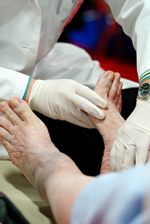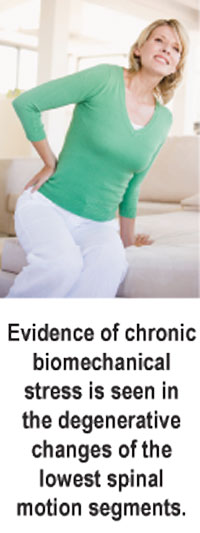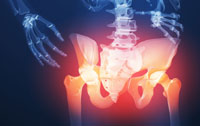History and Presenting Symptoms
A 66 year-old female presents with aching lower back pain and numbness extending into both feet. She reports having had occasional lower back pain for many years, but has only noticed the foot numbness in the past six months. This is getting more constant, which concerns her. She recalls no specific back or foot injuries. On a 100mm Visual Analog Scale, she rates her low back pain as usually 20-30mm. Both feet are equally numb, with no noticeable pattern or causative activity.
Exam Findings
Vitals. This 5’4’’ aging female weighs 168 lbs, which results in a BMI of 29. She is aware that she is bordering on obesity and has been unsuccessfully trying to lose weight. She hasn’t been able to exercise recently because of her back pain and numb feet. Her blood pressure is  elevated at 144/96 mmHg and her pulse rate is 84 bpm.
elevated at 144/96 mmHg and her pulse rate is 84 bpm.
Posture and gait. Standing postural evaluation finds evidence of abdominal obesity, with a loss of the lumbar curve, and an accentuated thoracic kyphosis. There is no significant lateral listing of her pelvis or spine. She demonstrates bilateral calcaneal eversion, with no evidence of medial arches bilaterally. During gait, both feet pronate substantially and flare outwards (toe-out).
Chiropractic evaluation. Motion palpation identifies numerous limitations in intersegmental spinal motion: the left SI joint, the lumbosacral junction on the left, L3/L4 on the right, T11/12 generally and at the cervicothoracic junction. Palpation finds generalized paraspinal muscle tenderness, but no specific muscle spasm in these regions. All active thoracolumbar spinal ranges of motion are limited slightly by aching pain and stiffness. Provocative orthopedic and neurological tests for nerve root impingement and/or radiculopathy are negative.
Lower extremities. Both feet are generally insensitive to both pinprick and dull pressure evaluation. No specific dermatomal or peripheral nerve pattern is identified. Manual testing finds no significant muscle weakness in the fibular (peroneal) or anterior tibial muscles on either side. The feet and ankles are moderately edematous and the skin is somewhat blotchy.
Imaging and Lab
A weightbearing lumbopelvic X-ray series finds generalized loss of lumbar disc heights, most obvious at the lumbosacral joint and L3/L4. The L3 vertebral body is translated forward approximately 5 mm. The sacral base angle and lumbar lordosis are both decreased, consistent with her postural analysis. Fasting glucose level is found to be 134 mg/dL.
Clinical Impression
“Diabesity” (central obesity and type 2 diabetes) with early peripheral neuropathy. This is accompanied by degenerative lumbar spondylolisthesis. She also provides evidence of poor support from the lower extremities, with hyperpronation and substantial calcaneal eversion bilaterally.
Treatment Plan
Adjustments. Specific, corrective adjustments for the SI joints and the lumbar and cervicothoracic regions were provided as needed, with good response. Manipulation of the feet and knees was also performed.
Support. Custom-made, flexible orthotics were provided, made of comfortable and supple viscoelastic materials. She was given instructions in proper shoe selection, including the importance of correct sizing. It turned out that her shoes were too small and she purchased better-fitting shoes (one full size larger), which then accommodated the inserts without difficulty.
Rehabilitation. She received instruction in a comprehensive spinal stabilization exercise program using elastic resistance tubing. She was shown how to incorporate an exercise log with her food diary, which she brought to each visit so her continued adherence to diet and exercise recommendations could be encouraged.
Response to Care
The adjustments were well-tolerated, and orthotics made a noticeable improvement in her postural alignment at the feet and the lumbopelvic region. Her low back symptoms resolved and her foot numbness decreased significantly. At eight weeks of 12 adjustments and daily home exercises, including wearing her orthotics, she was released to a self-directed maintenance program. She was encouraged to continue her diet and exercise program.
Discussion
The combination of obesity and type 2 diabetes (insulin insensitivity) is a growing problem. Once referred to as “adult onset,” this type of diabetes is now seen in adolescents. One result of altered glucose levels is peripheral neuropathy, which can present as bilateral “glove and/or stocking” paresthesiae. If numb feet are repeatedly traumatized, they develop sores and infections, with a real risk of amputation. Proper shoe fit and frequent foot self-examination are necessary in order to prevent further deterioration of foot health.
Dr. John J. Danchik, the seventh inductee to the ACA Sports Hall of Fame, is a clinical professor at Tufts University Medical School and formerly chaired the U.S. Olympic Committee’s Chiropractic Selection Program. Dr. Danchik lectures on current trends in sports chiropractic and rehabilitation.


 Exam Findings
Exam Findings



 The blessing of the right EHR computer system is that it protects you from audits, saves you time in the office, and increases your income. The time to accept and use this blessing is before an auditor pays you a visit.
The blessing of the right EHR computer system is that it protects you from audits, saves you time in the office, and increases your income. The time to accept and use this blessing is before an auditor pays you a visit.
 Dr. Mark Studin is the President of C.M.C.S. Management which offers the Lawyers Marketing Program,Family/MD Marketing Program and Compliance Auditing services. He can be contacted at
Dr. Mark Studin is the President of C.M.C.S. Management which offers the Lawyers Marketing Program,Family/MD Marketing Program and Compliance Auditing services. He can be contacted at 
 Dr. John J. Danchik, the seventh inductee to the ACA Sports Hall of Fame, is a clinical professor at Tufts University Medical School and formerly chaired the U.S. Olympic Committee’s Chiropractic Selection Program. Dr. Danchik lectures on current trends in sports chiropractic and rehabilitation.
Dr. John J. Danchik, the seventh inductee to the ACA Sports Hall of Fame, is a clinical professor at Tufts University Medical School and formerly chaired the U.S. Olympic Committee’s Chiropractic Selection Program. Dr. Danchik lectures on current trends in sports chiropractic and rehabilitation.
 Dr. Mark Studin is the President of CMCS
Dr. Mark Studin is the President of CMCS
